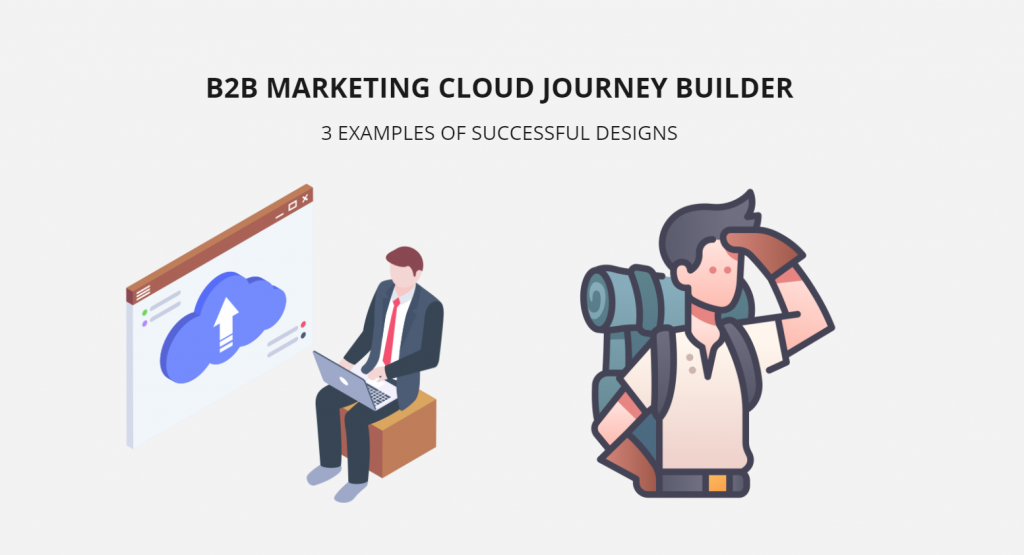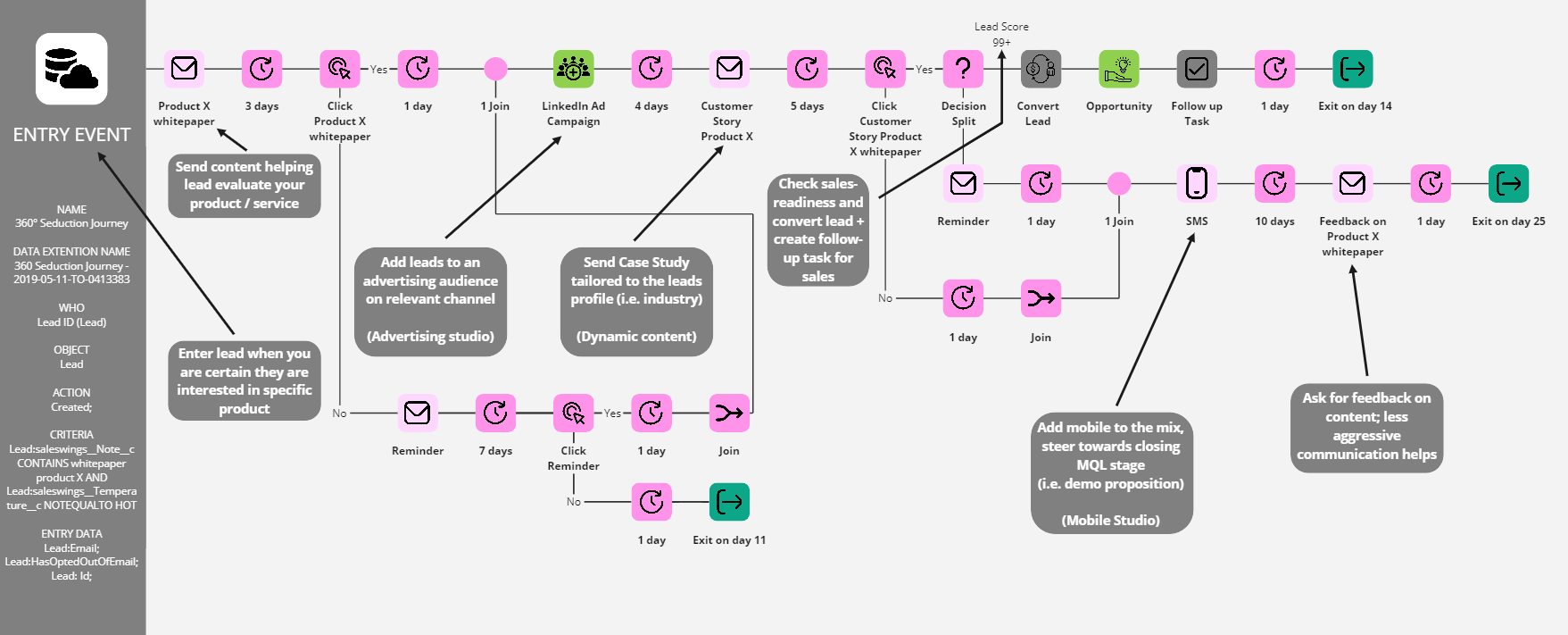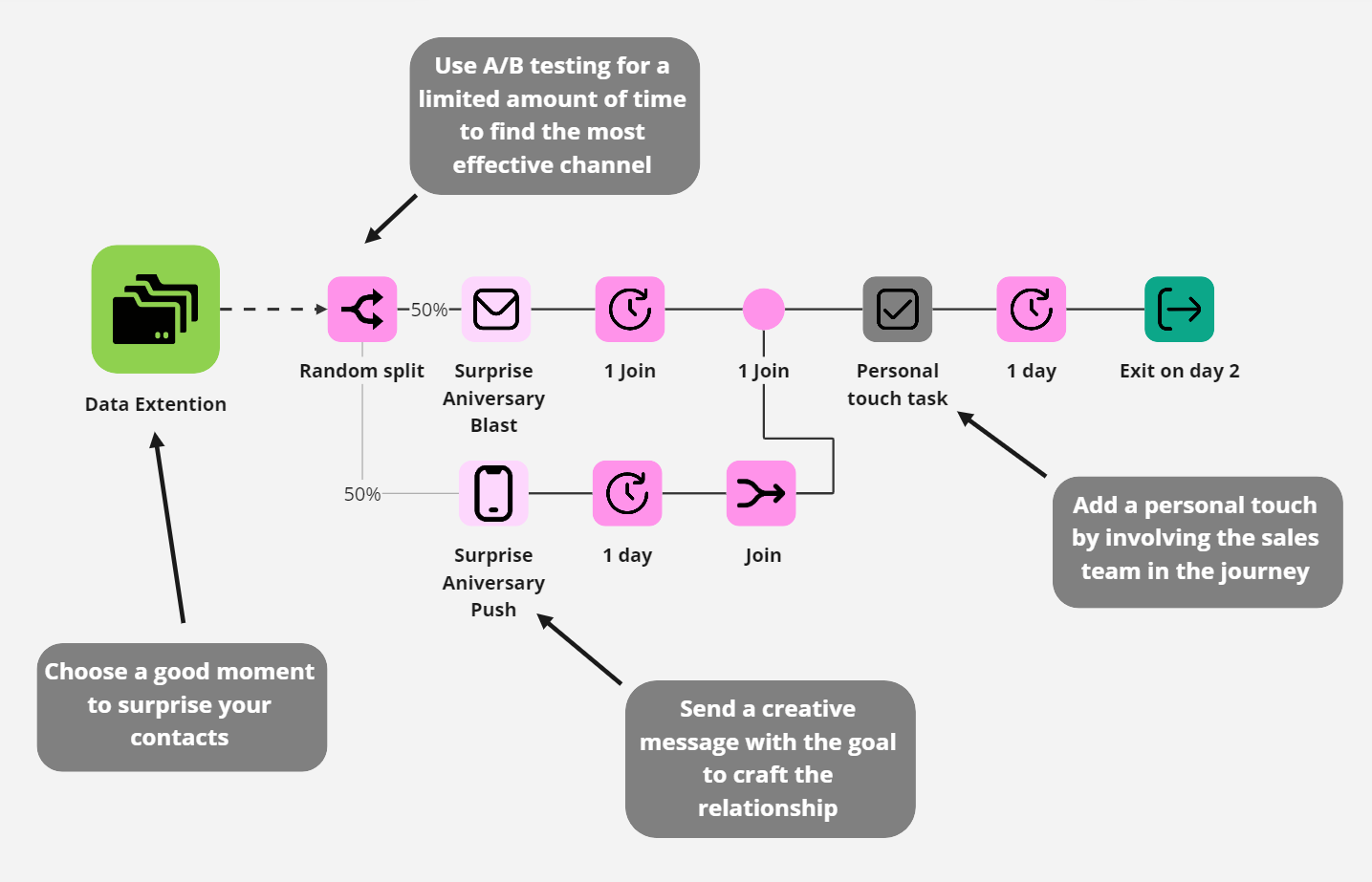
B2B Marketing Cloud Journey Builder: 3 Examples of Successful Designs
Marketing is in a lot of ways like love. First, you are excited. Following that, you are attempting to determine what the other person is interested in and how you may win their heart. After they go to bed with you (pardon the bold metaphor), it does not end there. Successful marketers are aware that “what got you here, won’t get you there.” Getting them to marry you and become a repeat client demands imagination and flair. And after you have established a stable relationship, you must maintain trust and interest in order to live happily ever after.
You have the tools to accomplish that thanks to the “Journey Builder” feature of Salesforce Marketing Cloud. Intent data, email, advertising, and much more are integrated by a strong group of “Studios” to create well-orchestrated, intelligent customer experiences. The studios offer excellent functionality at their core, and there are many strong add-ons available, including lead scoring for Salesforce Marketing Cloud by SalesWings or Litmus to guarantee email compatibility with more than 90 email clients.
But a tool is only a means to a goal, which is why we have included 3 different customer journeys that all B2B marketers should have in their toolbox.
Customer journey No.1: The ‘getting acquainted’ welcome journey
Use case: Newly acquired leads or prospects
The objective of the journey: Determine the interests of potential customers to provide a more customised experience for them (segmentation)
The relationship is still in its early stages. Imagine a new customer signing up for “General Company Updates” using a basic “Newsletter Sign-up Form.” If they are completely new to you, you will not know much about them:
- First and last name
- Email address
- The fact that they are generally interested in your content and business
- (Additional: Data on customer journey tracking)
- (Lead scoring)
- Segmentation data based on behavioural patterns
The objective of this phase is to get to know the consumer so that you can understand their interests and further tailor their customer experience (segmentation/audience building).
Suppose your company offers lead scoring, as shown in the simplified journey below (created using Marketing Cloud Journey Builder). In that case, you may want to directly create a new “lead” in Salesforce and assign a “follow-up” task to your sales team if the lead is “sales-ready” (in the example below, with a lead score of 50 points or higher).
You should send a first welcome email (“Segmentation Split”) to the remaining prospects with content that helps your team to divide the leads into specific groups. Imagine that you are marketing to three distinct personas, each identified by the department they are employed in.
As an example, if you are a financial services company with customers in three different branches (corporate, asset management, and private banking), you could provide content tailored to each of these fields.

Here, you send an email containing three topics that are distinct from one another and links to further content. It is crucial to include teases of the material within the email to encourage them to click through:
- The link to the first topic (which serves the interests of Persona #1)
- The link to the second topic (which serves the interests of Persona #2)
- The link to the third topic (which serves the interests of Persona #3)
You should implement a tracking solution (AMP Script or a third-party solution) on the three landing pages where these links land in order to track these clicks and visits. Therefore, you update the Marketing Cloud subscriber data within the data extension with an attribute “Topic 1” if a prospect clicks on the “Topic 1 link,” for instance, and reaches this landing page.
You keep delivering high-level content emails to those who do not click until you can determine their interests from these prospects.
This is an excellent method to learn more about how to develop a unique client experience for each new prospect.
Customer journey No.2: The “360-degree seduction” journey
Use case: A potential customer expresses significant interest in Service or Product X
The objective of the journey: The lead must be pushed or nurtured from the MQL (marketing qualified) stage to the SQL (sales qualified) stage and a demo
In this case, we are assuming that you were able to identify a lot of interest in a certain Product X. Now is the moment to speed up the process and put in a lot of effort to get them to a point where they are prepared to interact with a salesperson.
There are numerous different methods to start this journey, including:
- A lead acts on the website in a way that signals a high interest in Product X (multiple lead scoring/behavioural segmentation).
- At an event, a sales representative meets the potential customer. The representative determines that the lead is not yet sales-qualified, but the prospect expresses interest in Product X inside Salesforce CRM.
- The prospect submits a necessary form.
In the following example, we’ll assume that a lead fills out a web form to request a white paper on an issue that “Product X” of yours is addressing. Because the lead has expressed an explicit interest in your product, we want to generate the lead in Salesforce CRM so that a representative may have a look at them as well. You might use Salesforce’s “web-to-lead” form for this purpose, or if you need more power, consider Formassembly, which provides configurable forms for Salesforce or Marketing Cloud.
It is important to note that for this journey, we should preferably collect the following data from the lead:
- Mobile number – used to send SMS messages with Mobile Studio. (Note that you might request mobile number verification.)
- Industry or similar information in order to use dynamic content in emails
We use “Salesforce data” as an entry event. Either use “Salesforce data” to search for lead/contact fields (includes, for example, clicking a checkbox for that journey) or use a “Salesforce campaign” to add all contacts. With Salesforce Flows, this can be used to automatically add all of the leads that submit a form to a Salesforce campaign.

The Journey includes the following components and steps:
- Sending the White Paper to them via mass email, along with a follow-up reminder
As a rule of thumb, we prefer embedding material on websites rather than sending links to PDFs in emails for three reasons.
Firstly, this improves the SEO of your website and allows you to include additional content that may be of interest to the lead, such as price information or case studies. Second, being on a landing page encourages a lead to continue researching your website rather than simply closing the PDF. Finally, if you employ customer journey tracking technology, a PDF also cannot execute tracking javascript.
For instance, we created a single decision split that will guarantee that leads who don’t click on the emails still receive reminders. If the individual doesn’t click to acquire the whitepaper during two months, you could send up to five or six reminders, although we haven’t completely implemented this here.
- Including them in an advertising campaign on LinkedIn using the Advertising Studio
Remember, our goal on this journey is to attract them from all sides. We will thus show them Product X on the internet. One fantastic feature of Advertising Studio is the ability to quickly add a certain group of leads to an advertising campaign and retarget them while sending emails to them. In fact, Salesforce’s primary advantage is omnichannel marketing. While they are on their journey, these advertisements will continue to track them.
- Sending them an email including a client story for Product X from Industry Y
We will attempt to move the leads down the funnel by giving them more information that will aid them in determining if your product or service is a good fit for them, given that we are aware of their interest in Product X.
Remember that in order to make this customer story as effective as possible, we will select a customer story based on the industry (or other appropriate information) that the lead provided in the form. Basically, you want to create a dynamic content block, and then display them a Customer Story that speaks directly to their requirements by searching up the Salesforce CRM field “industry,” which has been prefilled once the lead has submitted the form.
In fact, Salesforce Marketing Cloud gives you a variety of options to integrate dynamic content. There are straightforward choices or if you want, you can get pretty creative with dynamic content.
- Using lead scoring (SQL) to determine if the lead is ready to talk to a sales representative
The sales and marketing teams may align on the most important leads by using lead scoring. Many marketers encounter difficulties in timely delivering the proper leads to the sales team, which irritates and annoys the sales representatives. You may use a third-party lead scoring tool for Salesforce Marketing Cloud, such as SalesWings, or you can write code and rules yourself to implement lead scoring in Marketing Cloud in a variety of methods.
In Marketing Cloud or Salesforce CRM, you can look up the lead scoring field using a “Decision Split,” which will then convert the lead into a contact, account, and opportunity.
- Integrating mobile channels into the journey strategy by utilizing the Mobile Studio tool
SMS is a necessary component of 360-degree seduction. As you may recall, we requested the cellphone number when the user signed up. Checking to see if you already have a cellphone number on file would allow you to preserve this field’s optionality.
You have a few choices here. Since you are striving to prepare the lead for sales, why not offer a demo with a few slots and introduce the specific account manager? Or as another example, you could invite them to a forthcoming event or online seminar related to Product X.
- Completing the process (SQL)
Based on lead scoring, you may send them an email asking for comments on the downloaded paper or suggesting a demo if you haven’t been able to make contact or move them into a sales-ready position. If you don’t ask, you don’t receive, after all. When addressing a problem or a solution, leads who are seriously considering a product or service may be seeking validation.
Here, sending an email as plain text with the appearance of one-on-one correspondence will make it more personalised and increase the likelihood that you’ll receive a response.
Customer journey No.3: The “Unpredicted Stingray Surprise” loyalty journey
Use case: A short yet imaginative anniversary or birthday journey
The objective of the journey: Create a better bond and relationship with your leads by surprising them with a memorable experience
Shorter journeys bring instant results and are easier to initiate and sustain. Consider a few shorter journeys to accompany the general approach.
Professor Werbach of the University of Pennsylvania State University discovered in his Gamification study that surprise and unexpected benefits had a greater impact than expected ones.
This journey can be started at any time. For example, it is your lead’s birthday. Or it is his first anniversary of being a customer.
Now, let’s take a look at what this journey could look like.
Because this is a time-sensitive event, you should use Salesforce CRM or a specific data extension as an input data source and select a specific time field. Birthdays, first purchases, subscription start dates, and so on.

This journey should include the following steps:
- Sending an initial message, either via email or SMS, which includes up-to-date content
Making people feel as though they are just an “income source” does not inspire loyalty since people have an inner need to be respected as human beings.
You could start with something like “It is your birthday today! Find out 3 best ways to celebrate such a special day “.
Data is key, as always, and you could tailor this journey to your customer’s gender, age, location, or other characteristics by gathering information about them. For example:
“Spend exciting holidays in a luxury ski resort – it’s on us!” – You might be able to provide a coupon or a simplified reimbursement if you collaborate with a large hotel chain. Alternatively, you could just give a list of wonderful spas and massage locations, ranging from the all-inclusive Turkish Hammam to the traditional “mud massage”.
“Take a break from technologies – turn off your phone and disconnect from the internet!” – Another brilliant suggestion could be a digital detox. Nowadays people are so absorbed in their devices that switching off would undoubtedly make them feel better.
A coupon or voucher for a small gift. – Many people also favour making their own decisions. Why not offer them a little voucher for their favourite items from Amazon, iTunes, or the movie industry? You may also use the fantastic “Coupon” function that is already included in Marketing Cloud.
- Creating a follow-up task for the account manager
In terms of customer experience and automation, customers are well aware that many things are automated, which devalues them.
To add a human touch, consider encouraging the account manager to follow up or send a personal letter. It is more expensive to get timely communication from a person, but since business is conducted between individuals rather than businesses, this time is wisely spent.
It’s done now!
The Marketing Cloud Journey Builder is a wonderful tool that gives you all the tools you need to design unique, effective, and successful customer journeys. You can align sales and marketing efforts and make sure that your team is fully prepared by using third-party tools like SalesWings for Salesforce lead scoring or comprehensive forms like Formassembly.
Was this article helpful?
Support us to keep up the good work and to provide you even better content. Your donations will be used to help students get access to quality content for free and pay our contributors’ salaries, who work hard to create this website content! Thank you for all your support!
Reaction to comment: Cancel reply